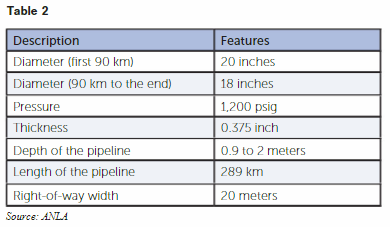June 2021, Vol. 248, No. 6
Features
Colombia Oil Industry Ready for New Jobo-Transmetano Gas Pipeline
By Mauro Nogarin, South America Correspondent
Since the beginning of the pandemic, apart from the three critical months of March, April and May 2020, the Colombian oil industry best knew how to face this difficult situation in Latin America.
Although it had to adjust its annual investment plan published in January 2020, from a financial perspective, the main national companies optimized economic resources effectively, guaranteeing both production and the expansion of the natural gas transportation network and oil in Colombia.
Undoubtedly, the $400 million Jobo-Transmetano, expected to go into service in December 2024, is the biggest evidence of this.
According to a recent study carried out by the Ministry of Mines and Energy, Colombia will face a gas shortage between 2023 and 2025. Among the main causes are the natural decline of the main producing fields in the Ballena and Cusiana regions and the increase in the demand for natural gas that in recent years reached 400 MMcf/d (11 MMcm/d).
Taking into account that the Guajira and Cusiana fields are the main sources of supply for the inland market, it is clear that the gas deficit will affect this area, which represents 62% of the total demand for natural gas.
Conversely, on the Atlantic Coast, the situation is exactly the opposite, in that the market could be fully supplied, even having surpluses that could be used in the interior market. This surplus is the result of the production potential of the Lower Magdalena Valley (VIM) area and the eventual backing of the Cartagena regasification plant.
In this area, producers have stated that they have significant gas reserves that can guarantee production of 100 MMcf/d (2.8 MMcm/d) with an inlet and outlet pressure of 1,200 psig (83 bar) over the course of a 10-year operating contract.
For this reason, it is essential that of the new 179-mile (288-km) Jobo-Transmetano gas pipeline be built.
Since 2016, Promigas has carried out studies on an area of 13,745 square miles (35,600 km2) to identify alternatives for the gas pipeline that will connect the geographical area of the Valle Inferior del Magdalena basin, located in the Sucre and Córdoba areas, to the markets of Antioquia and the interior of the country.
The National Environmental Licensing Authority (ANLA), at the end of May 2019, approved the third alternative, which covers 230 square miles (596 km2) and requires crossings at the San Jorge, Rio Man, Rio Cauca, Rio Cacerí and Rio Nechí Rivers. (Table 1)
The Jobo Station project is located at an approximate height of 279 feet above sea level (85 meters above sea level [MASL]), while the Guacharacas Station is located 3,917 feet above sea level (1,194 MASL).
The trunkline begins from the Jobo Station, near the municipality of Sahagún in the Cordoba region, continuing south to Pueblo Nueva, Planeta Rica, Buenavista, La Apartada and the town of Caucasia.
The route continues to the municipality of Cáceres, in the Antioquia region, moving east to the town of Zaragoza and further south to the city of Segovia.
Along the same axis, parallel to the provincial route, the route connects the cities of Vegachi, Yalí and Yalombó, before reaching the Tasajerade Transmetano Station.
The connection point of the project to the National Transportation System (SNT) will be located at the Guacharacas Operating Station, located at the 50-mile (80-km) mark of the SNT Sebastopol-Medellín gas pipeline (owned by Transmetano) to deliver the natural gas. (Table 2)








Comments